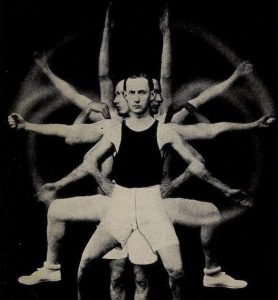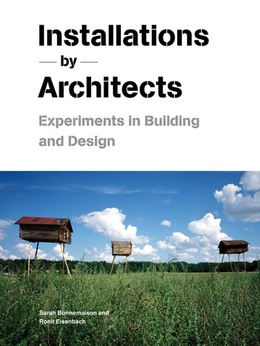 Installations by Architects: Experiments in Building and Design, by Sarah Bonnemaison and Ronit Eisenbach (Amazon USA and UK.)
Installations by Architects: Experiments in Building and Design, by Sarah Bonnemaison and Ronit Eisenbach (Amazon USA and UK.)
Publisher Princeton Architectural Press says: Over the last few decades, a rich and increasingly diverse practice has emerged in the art world that invites the public to touch, enter, and experience the work, whether it is in a gallery, on city streets, or in the landscape. Like architecture, many of these temporary artworks aspire to alter viewers’ experience of the environment. An installation is usually the end product for an artist, but for architects it can also be a preliminary step in an ongoing design process. Like paper projects designed in the absence of “real” architecture, installations offer architects another way to engage in issues critical to their practice. Direct experimentation with architecture’s material and social dimensions engages the public around issues in the built environment that concern them and expands the ways that architecture can participate in and impact people’s everyday lives.
The first survey of its kind,Installations by Architects features fifty of the most significant projects from the last twenty-five years by today’s most exciting architects (…) Projects are grouped in critical areas of discussion under the themes of tectonics, body, nature, memory, and public space. Each project is supplemented by interviews with the project architects and the discussions of critics and theorists situated within a larger intellectual context.
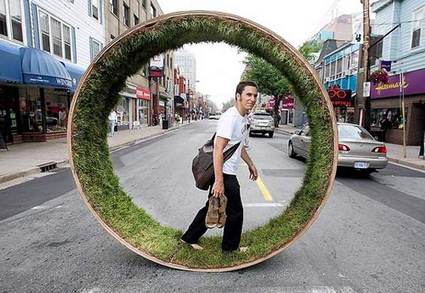 Asher DeGroot, David Gallaugher, Kevin James, and Jacob Jebailey, Walking in the Park. Photo credit: Andre Forget (via)
Asher DeGroot, David Gallaugher, Kevin James, and Jacob Jebailey, Walking in the Park. Photo credit: Andre Forget (via)
You probably saw many examples of architects installations if you attended the latest Biennale of Architecture in Venice. They provide new platforms for innovative perspectives, ideas and experiments in the field of architecture. Some of these installations will remain at the experimental stage, others might later be implemented into built work. Installations, especially when temporary, enable architects to work outside the constraints dictated by clients and city regulations. The main purpose of installations is not necessarily to be useful but to generate conversations, to invite viewers to reflect on the role and essence of architecture. Installations are also vehicles for teaching and research as the Bauhaus was one of the first schools to demonstrate. Finally, young studios can find in installations a fantastic opportunity to advertise their talent.
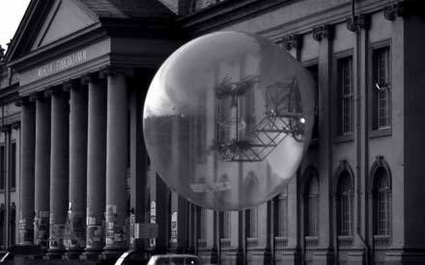 Haus Rucker & Co, Oasis for Documenta 5, Kassel, 1972
Haus Rucker & Co, Oasis for Documenta 5, Kassel, 1972
I expected Installations by Architects: Experiments in Building and Design to be one of those fancy volumes you open to find big, glossy photos and little text to comment on them. I was expecting a beautiful book that lingers on the coffee table for your guests to admire. There are loads of images in the book indeed but there are even more essays by critics, by theorists and by the authors (Bonnemaison is an associate professor of architecture at Dalhousie University and Ronit Eisenbach is an associate professor of architecture at the University of Maryland). Architects get to give their own view as well. The book is divided into five chapters that explore a different area of discussion. Each of them is illustrated by 8 to 10 architectural installations (this post picks up one of them for each chapter):
1. Tectonics: by exploring new modes of assembly and materials, this section reminds us that architecture doesn’t stop at the facade.
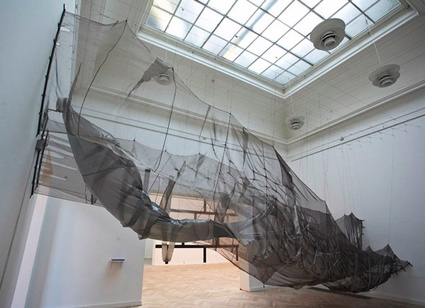 Mette Ramsgard Thomse, Vivisection
Mette Ramsgard Thomse, Vivisection
Mette Ramsgard Thomse’s Vivisection is a spatial experiment that explores how a techtonic surface can embed a capacity for sensing and actuation. The silk and steel fabric is conductive thereby allowing the architects to pass electronic signals through it. By using antenna based sensor chips the fabric “feels” the presence of the audience. The sensors inform a network of distributed micro-computers, that in turn control the fans, inflating and deflating internal bladders in the structure.
2. Body examines the relationship between human body, spatial experience and design.
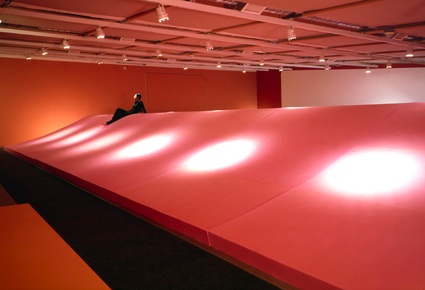 Thom Faulders, Mute Room (image)
Thom Faulders, Mute Room (image)
Thom Faulders covered with pink Memory Foam (as used in the earplugs that expand to fill the cavity of the ear) the floor of his Mute Room, a temporary listening environment for experimental electronic music. The foam’s surface operates as a sound baffle to enhance acoustical clarity. Similar to the way that musical notes ‘decay’ in the air before dissipating, this surface has a transitory quality – impressions linger until fully erased by the slowly acting foam.
3. Nature might help shape a more responsible attitude towards nature.
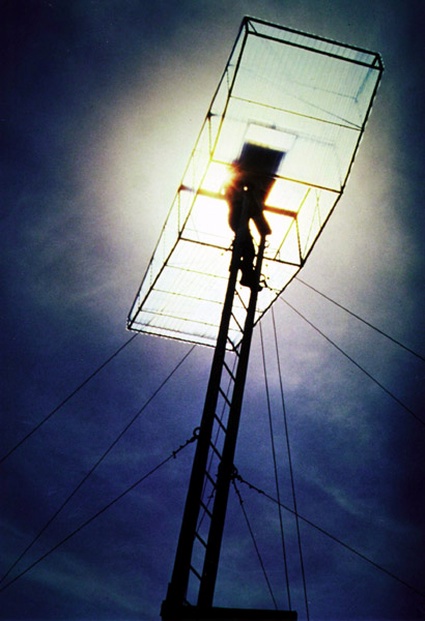 Anderson Anderson with Cameron Schoepp, Prairie Ladder
Anderson Anderson with Cameron Schoepp, Prairie Ladder
The Prairie Ladder was commissioned by the Connemara Conservancy (Texas) to preserve, protect, and honor the prairie landscape.
The ladder introduces a veritcal axis, making a departure from the natural horizontal axis of the prairie. The ladder also proclaims human defiance of the horizontal limitations of the earth.
4. Memory engages with the collective memory and its relationship with space.
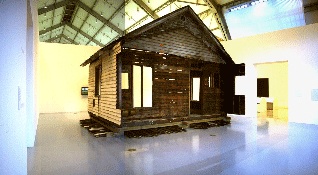 24260 in “art and Economy at Deichterhollen, Hamburg, 2002
24260 in “art and Economy at Deichterhollen, Hamburg, 2002
Since 1960, Detroit has lost half of its population and demolished over 200,000 housing units. Kyong Park‘s 24620: The Fugitive House (2001-), is an abandoned house from Detroit that has been dismantled and reconstructed in several European cities. 24620 is looking for a new home in a ‘kinder and gentler” city than Detroit. Europe, however, is becoming just as neo-liberal and neo-con as in the USA
With its pieces misplaced and their incisions permanent, the house, when re-assembled, replicates the condition of a dysfunctional city in the violence of dismembered spaces. Wherever it may go, the house takes the ideals and failures of modernism with it, creating discourses on the cultural state and destiny of each community.
5. Public Space offers citizens new ways to inhabit or relate to the city.
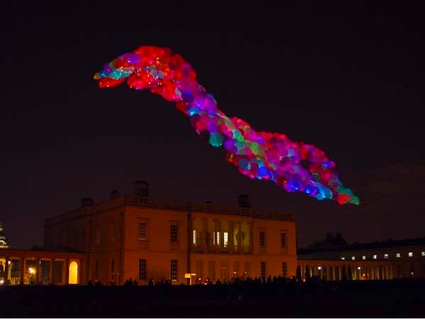 Usman Haque, Sky Ear, 0n September 15, 2004 at the National Maritime Museum, Greenwich Park, London
Usman Haque, Sky Ear, 0n September 15, 2004 at the National Maritime Museum, Greenwich Park, London
Sky Ear, by Haque Design + Research, contains miniature sensor circuits that respond to electromagnetic fields, particularly those of mobile phones. When activated, the sensor circuits in the clouds co-ordinate to cause ultra-bright coloured LEDs to illuminate thousand glowing helium balloons.
Related book reviews: Bright: Architectural Illumination and Light Installations, Spacecraft Fleeting Architecture and Hideouts and Ground-up City. Play as a Design Tool.
Image on the homepage: land(e)scape (Savonlinna, Finlandia – 1999) by Marco Casagrande and Sami Rintala.




